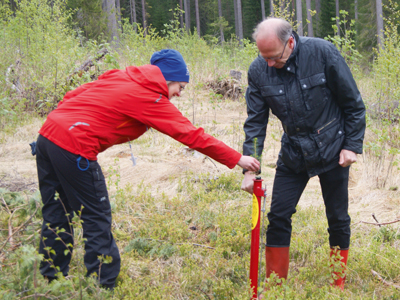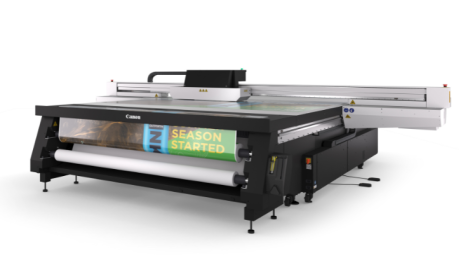SCA is the owner of Europe’s largest private forest with 2.6 million hectares of stretching across northern Sweden
To show the sustainability of paper production, consumers were given the chance to follow the process from the forest to finished product. By Michal Lodej.
Two Sides’ No Wonder You Love Paper Campaign gave 30 winners, and their partners, the chance to see first-hand, sustainable forestry in action. Ten paper producers – Burgo, Holmen, IP, Lecta, Mondi, Norske Skog, Sappi, SCA, StoraEnso and UPM – hosted the winners throughout May and June offering the chance to visit one of their mills, explore the forests and learn about sustainable paper production.
The SCA site in Sundsvall, Sweden, was the mill visited by Digital Printer along with some of those winners. With 2.6 million hectares of forest land SCA is the owner of Europe’s largest private forest stretching across northern Sweden. Founded by the inventor of the safety match, Gustaf Eric Pasch, the company has always had timber production at the heart of its operation.
The forests are both FSC and PEFC certified and have an annual growth rate of 1.5%. This is key to the company’s environmental contribution, as well managed forests help to solve the climate change problem and SCA’s absorb more carbon dioxide than is discharged from its entire production.
While it is in the firm’s commercial interest to grow the forests, it is also legally required to replant any tree harvested within two years, and so the nursery becomes a vital part of the supply chain.
Back to nursery
Jurgen Andersson, nursery manager told visitors, ‘Seeds are taken from a seeding orchard rather than out in the forests, which gives us a better quality of seed, as the trees in the orchard have been managed. This technique increases production by around 12% than it would by taking seeds directly from the forest.’
The nursery produces four crops a year with each seed checked individually for its growing potential. The seeds are grown in peat rather than soil, as soil is unpredictable in terms of what it will contain and so will not produce consistent results.
You may think Sweden is the last place to find an artificial snow machine, however, it is vital to the early growing stage. The company tries to replicate nature as much as possible and if there is not enough snow in the winter, which happens more often than not, then the nursery has to create its own snow to cover the seedlings once they have been moved to outdoor plantations. The layer of snow helps to insulate the seedlings against frost, which would kill them.

Winners of Two Sides’ No Wonder You Love Paper Campaign planting out saplings
Once the sapling is ready to go into the forest, each one is planted individually. This amount of labour requires a collective effort from the community in Sweden. Many schools or youth football clubs will volunteer to help plant the trees; a process which the winners were all able to experience themselves first hand. Trees are grown from between 75-100 years before being harvested.
Harvest time
When the trees are harvested they are split into two sections, the smaller top half of the tree is used for pulp, while the larger base of the tree will be used for lumber. These days the decision of where to cut is calculated by a machine, as almost all the steps are now automated. While harvesting, the company tries to leave trees which grew wild, and also leaves at least 10 trees per hectare. Imitating nature as closely as possible is essential, and the harvested area should be populated as it would be after a naturally occurring forest fire. The remaining trees also have a positive effect on the growth of the tress to be planted in that area next, providing a commercial as well as ecological advantage
Heavy cutting machinery is used to quickly harvest the forests. A skilled operator can cut down two trees per minute and over a year will cut down approximately 90,000 cubic metres of timber.
From forest to factory
The next step of the process is turning timber into pulp. SCA’s Östrand mill produces Celeste, a chemical pulp (425,000 tons/year), and Star, a machine pulp (95,000 tons/year). Highlighting the sustainability of paper production is the system at the mill, which generates electricity using heat generated by the pulping process. There is a major investment under way at the mill which will more than double production of chemical pulp to 900000 tonnes. It represents the biggest private industry investment in Sweden since the Second World War, totalling 7.8 billion SEK.
Just down the road from Östrand is the paper mill Örtviken, where the company turns pulp into paper. Here the company produces coated and uncoated publication papers – products for magazines, catalogues, supplements, commercial prints and newspapers. Its LWC paper is used for high quality magazines and advertising materials with demanding colour printing requirements. It also produces GraphoInvent, and uncoated paper for magazines, inserts and direct mail. This is a bright bulky paper, which is offered as an alternative to wood free uncoated papers.
As the market it serves changes, the company has had to adapt, forcing SCA to slowly reposition itself away from newsprint production as the newspaper market continues to decline.
Public opinion
But what did the visitors make of all this information? The winners on this particular trip were from various parts of the UK and had seen the competition either in a printed publication or online. They had no ties to or experience of the printing or paper industry and so a common observation from each of them was simply, ‘Wow, I had no idea’. Paper is severely underrated by the public, and its use is taken for granted; it has always been there and always will be. For that reason its presence is almost completely ignored. While everyone knows that paper is made from trees, these competition winners now understand that it is not that simple and paper is a sustainable product. While they may not be able to evangelise the rest of the population into using paper products over digital technology, they may at least ignore those disclaimers on the end of emails – think twice before printing – and even try and enlighten those around them. As the founder of SCA, Gustaf Pasch, knew too well, it takes one tree to make a thousand matches, but only one match to burn a thousand trees; these 60 new missionaries may well be the matches to strike a new understanding about paper into the general public.





